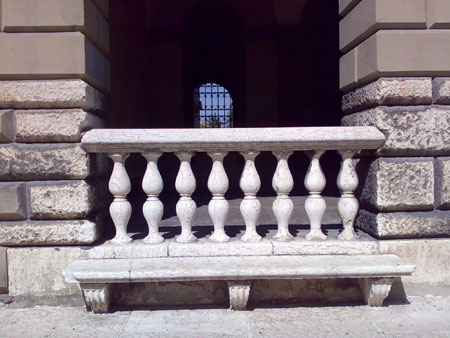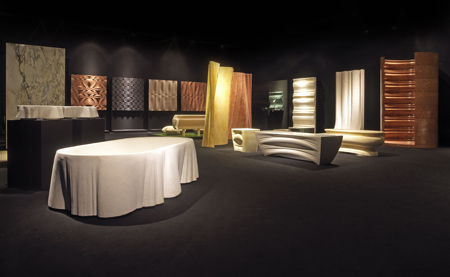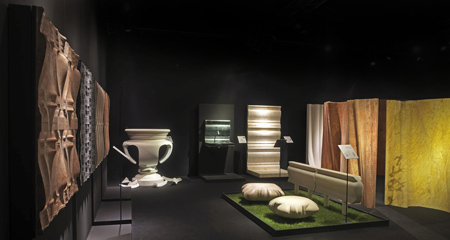9 Gennaio 2009
English
Lithic design

[photogallery]dl_album[/photogallery]
Beyond industrial design
The well-known adjective-noun combination industrial design has been dominating the scene and the recent history of objects and has created (as well as spread) a one-sided – and if possible, even tendentious – vision according to which the sole authentic features of contemporary design are those belonging to mechanization and automation together with those of the mass-production of objects in series.
In the second half of the twentieth century the well-known name of Italian design on the international scene (and possibly of products made in Italy), established itself under this idea and the consequent method which constituted its essence, confirmed a formal break with the past and consolidated a scenery dominated by materials and objects, an expression of a predominantly industrial and artificial society.
Even Italian design – a very particular version of international industrial design – is bound to the development of modern (i.e. industrial) techniques and to the reality of mass-production, thus ideologically taking its distance from the rich and varied pre-industrial tradition, the only one capable of lighting up many aspects and features of the Italian artistic, architectural and urban history. The tradition had for centuries lived on the superiority of ancient culture and its numerous revivals, which bestowed on us èlitist and original pieces of decorative art along with anonymous and yet elegant objects of everyday use, that were the result of a long time improvement in the models brought about by a widespread and varied materialism in the country.
Nowadays the rules and the conditions under which material goods (and non-material ones, at the same time) are produced have notably changed, due to the extraordinarily fluent and multiform spirit of economic globalization and by the extremely “virtualized” experiences of life which started off at the beginning of the new millennium which intermingles postfordism, new economy, flexibility and new forms of work organisation-distribution.
The typical modern axioms of industrial production related to the concept of a factory firmly rooted in a specific place and the serial production of objects, no longer represent the only and absolute conditions underlying the existing economic growth strategies.
The dichotomy itself between industrial technology and a craftsman-like approach appears nowadays to be fading behind the ideas of flexible and integrated work fostered by the tailor-made strategy. Craftsmanship and home-made products are now marching along side by side with state-of-the-art technology, large series of objects obtained through mechanization coexist with small ones, diversified ones, custom-built ones and exclusive ones.
When we look at the specific question of the relationship between production and design by taking into consideration this rearranged general framework of economic globalization, we can see that, as far as Italy is concerned, what has long been hidden by a sweetened and “partisan” vision of industrial design is now emerging, even though it is constantly feeding on these foundations.
By this we are referring to a non-material space, to the aesthetic background and taste of a country where Italian designers’ creativity has developed, supported on the production front where the artisan knowledge is spread throughout the land and has fortunately been preserved over the years up to present time.
Within this external-internal debate (Italian system-industrial design) experimental stages, which widely used prototypes able to carry out the verification of design projects, freed from the rigid conditions that came from the Fordian work model, have often come immediately after creative and prefigurative ones. Sometimes these prototypes have been forerunners of objects which were to be mass-produced, other times they were destined to remain “solitary tokens” (memory of unsuccessful attempts), or to be produced in small numbers, anticipating the limited edition design fashion which has been imposing itself in recent times.
We firmly believe, however, it is essential to trace that vital lymph sustaining the original creativity of “made-in-Italy” by going back to the historical roots and to the country’s long-time identity rather than sticking only to the contribution and craftsmanlike skills which were the basis of the successful outcome of Italian design in the second half of the twentieth century.
In our view, it is Italian taste, beauty and artistic wealth – from the “small” masterpieces (which can be admired in the countless museums or at noble residences) to the charm of the architecture and the old towns, as well as the landscape and nature– which feed and link the contemporary spirit of Italian design (including the industrial one) to its roots and to the historical continuum over the centuries, dating back from the Baroque period towards Renaissance, late-antiquity, antiquity.
If we do not understand the existing invisible thread, which has never been entirely broken, tied to the territory and to its values, which still emerge despite the vast sea of contemporary homologation, we would not be able to explain the reasons which lie behind the enormous vitality and creativity regularly expressed in Italian design; and, as we said, such vitality and creativity are fostered and enriched by the practical-manual skills of Italian craftsmen, generously transferred to the industrial production, however indirectly.
In our opinion, this special condition expresses the peculiarity of Italian design compared to other countries.
It is no coincidence if made in Italy products are still of outstanding importance on international markets – as shown by the balance on the credit side in exports for the past five years. A lot is due to products involving a high level of creativity which reflect the territorial identity and which are bound to our lifestyle (interior decoration, fashion, food and wine, etc.) as well as to the image (highly historical) of the country which is appealing and act as an experiential background (real and virtual) in the international collective imagination.
On this Italy – reinterpretable, according to the view of Kevin Roberts of Saatchi & Saatchi as “the identifying territorial lovemark” – and on its product market structure there seems recently to be a new “pressure” from the outside, which is affecting lives, experiences, tastes, materials and goods, thus influencing production cycles.
We are specifically referring to the power of the emergent countries, which are progressively strengthening and increasing the demand for luxury products and experiences – this “necessary luxury” which has recently been studied by analysts in order to highlight the significant “expansion” in the demand for high quality products and services, exclusiveness and manufacturing excellence, either artisan or industrial.
We therefore find Italy being visited again – as in Goethe’s time – by “talent scouts” of luxury (and, more generally speaking, of typical national features) who look for and discover all those things which other countries cannot offer.
Next to mass-produced objects, fruit of contemporary Italian industrial design of quality, we can see the search for niche products, often expensive and èlitist, which confirms the “long tail” theory of the exploitation of net economy in order to discover them beyond the mass market, as described by Chris Anderson in the well-known essay The long tail.
Palladio and lithic design
We would like to leave the general question and shift our attention to a more specific and relevant dimension where the term design is understood in its etymological significance freeing it from a vision which has relegated contemporary designers (“architects of small things”, as someone has called them) to turn to working solely towards the industrial world of large numbers of mass produced identical objects.
As clearly stated in A Philosophy of design by Vilèm Flusser, to design means –– ‘to concoct something’, ‘to simulate’, ‘to draft’, ‘to sketch’, ‘to fashion’, ‘to have designs on something’.
And, according to the philosopher of Prague, “this design represents a coming together of great ideas, which – being derived from art, science and economy– have cross-fertilized and creatively complemented one another.”
The exhibition Palladio and Lithic Design, conceived and arranged by Raffaello Galiotto, is a fortunate and favourable opportunity not only to enter a broader and more open concept of design but also to return to the rich national history made of different stages, of visual experiences and of that material culture to which we referred at the beginning of this essay.
In particular, in order to understand the connection with the heritage of the territory around Vicenza and the tradition of objects made of marble and pre-industrial ornamental stones, we need to know, read and interpret again some works on elements of interior decoration of Andrea Palladio, the first and greatest global architect to have widespread influence in other countries, from England to America, from France to Russia. This is the perfect occasion to reconnect contemporary design to the great tradition of ancient marble objects.
A written contribution by the Consorzio Marmisti Chiampo, proud sponsor of the exhibition, very efficiently reviews the re-reading and virtualization of Palladio’s works. Very often the anonymous and concise papers belonging to the work associations are able to set the main ideas of the projects:
“The important occasion of the celebration of the 500th anniversary of the birth of the great architect Andrea Palladio has been the incentive for the study of a project inspired by the works made by the world’s most well-known “stonecutter” and for the realization of an exhibition which pays homage to designer objects made of stone. The event has been carried out thanks to the long-established art and skill of the marble craftsmen from the Chiampo Valley.
Thanks to the detailed and original research by the designer Raffaello Galiotto, and the vital cognitive contribution of CISA, it has been possible to identify some Palladian works that can be considered the “prototypes” for a modern concept of design.
A series of recurring straight and curved lines has been recognized in these works and objects.
Starting from the analysis of these lines and from their re-elaboration, the designer Galiotto has been able to create a series of modern designer objects made of marble, stone and granite.”
Raffaello Galiotto has worked on this specific experience with great courage and outstanding creative strategy, leaving behind the somewhat stereotyped path of traditional logic that we can see in industrial design, and aiming at an ideal public of lovers of “luxury and beauty” with a classical taste ; at the same time, he has set in some prototype-works a new formal tone which enables the general project-concept to open up towards timeless horizons.
The common denominator of all the prototypes prepared by Galiotto is the intense and lively creativity aimed at the prefiguration of interior decorations or the design of surfaces, which reveal highly vibrant features as far as shape, material and taste are concerned, almost as if they were pieces of designart.
The prototypes at the exhibition clearly show how creativity and formal experimentation are fundamental and, perhaps, even more important than the purpose and the use for which the object is intended.
Some of the pieces exhibited are interesting examples of morphological innovation with great emphasis on the aesthetic element, which places Galiotto’s work between art, design, and architecture in the search for new starting points and shapes for lithic design.
A real sense of shape and material is evident in the three-dimensional lithic design which powerfully interprets the monolithicity and the varietas of colour-sign of marble, stone, granite; we believe that such features constitute the real conceptual link to the starting point, to the works by Andrea Palladio.
The shift from an ideal reality to a physical one has not been underrated in the pieces which are exhibited.
Raffaello Galiotto’s entire project is based on top-quality lithic materials, refined and different for each object, state-of-the-art technology, which enables the transformation and the moulding of the material, and the completion phase and finishing by skilled craftsmen.


The strategy of flexibility and the integration between man and machinery has been consciously adopted in order to best exploit both the ancient traditions and skills of the marble craftsmen of the Chiampo Valley, as well as the increased and extraordinary potential of the state-of-the-art machinery used by the companies belonging to the Consorzio Marmisti of Chiampo which have supported and made it possible to carry out the project “Palladio and lithic design”.
Alfonso Acocella
